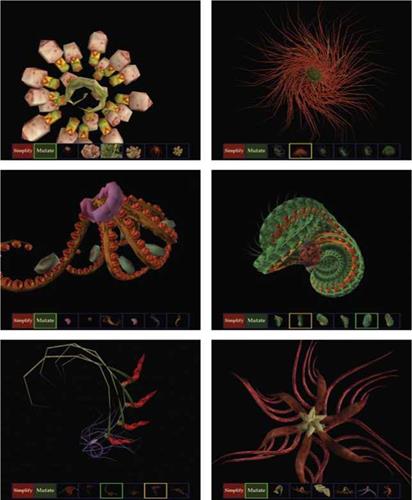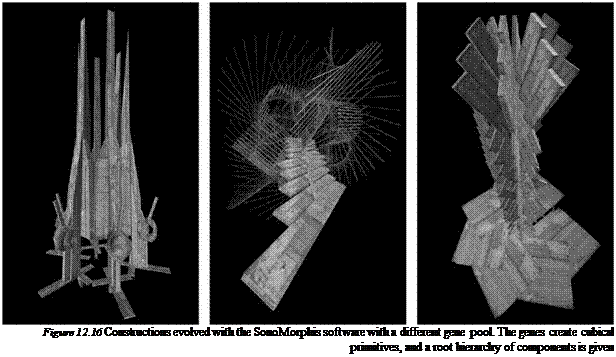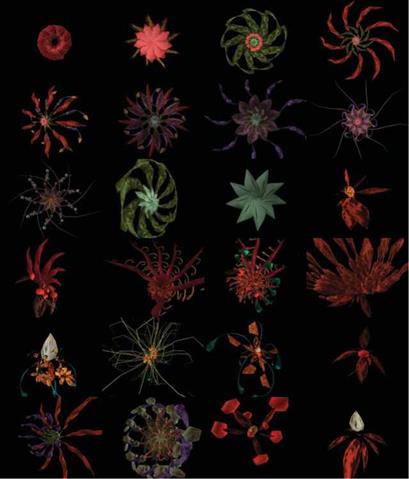SonoMorphis is an installation with genetic graphics and sound, developed by Torsten Belschner and one of the authors (Bernd Lintermann). A first version without sound was developed between 1995 and 1997[15], and extended to include sound in 1998 in co-operation with the audio designer Torsten Belschner at the ZKM Karlsruhe. The goal was to develop an audiovisual instrument that is varied and flexible enough to react exactly and in a nuanced way to the sound of an instrumentalist. The range of possibilities should be such that an expressive, variable, and complex play develops.
On the front wall of an area the stereoscopic image of a branched organic structure is projected, which consists of individual forms such as balls, leaves, and arms being in constant motion. In the corners of the area four loudspeakers are located, which project the object acoustically into space. In the center of the area a control interface is located. Using buttons and sliding controls, the viewer can determine the composition of the object, thus its visual and sound elements, as well as their variation in form and sound.
SonoMorphis was implemented on the basis of the Xfrog modeling system, which was extended to offer the option to automatically generate new hierarchies from a set of given components through the operations “insert”, “delete”, and “mix” (crossover of component hierarchies). A set of 32 predefined components serves as a “gene pool” of the system. Each component contains ad-
ditional data concerning interactively changeable parameters as well as compound cyclic or random parameter changes apart from texture and color information. Each scalar parameter can be animated by default using an average value, a range of variation, the softness of the change, and speed. Time-coupled parameters, with the help of sine functions and spline-based functions, cause the object to pulsate.
|

The structure of the object is represented by the p-graph described in Chap. 6. It can be changed by the viewer using the operations “mutation” and “simplification”. The system generates six automatic variations of the structure and represents them as frames on a border at the lower end of the projection. The user can successively select the desired changes, whose additional components grow out of the projected object, or whose missing components disappear slowly. The
last selected form becomes the starting point for further mutations. The kinds of operations that are selected internally in a mutation are random. They are limited, however, according to an estimation of the expected graphical complexity of the model. Parameters of the objects, such as lengths, thicknesses, bends, movement impulses, numbers of duplications, and so on, can be influenced dynamically by means of the sliding controls of the control equipment. An object can be moved, turned, and viewed from different perspectives; it can change its form, complexity, and also its sound.
![]() Interaction between form and sound is conceived in such a way that the basic data structure is represented simultaneously in two aesthetic modes: on the one hand by its graphical representation, on the other hand by the interpretation of the sound.
Interaction between form and sound is conceived in such a way that the basic data structure is represented simultaneously in two aesthetic modes: on the one hand by its graphical representation, on the other hand by the interpretation of the sound.
|

Chapter 12 A hierarchy between image and sound should be avoided. The selected sounds Media Art are inorganic, they remind one more of machines, engines, or metallic bodies

than of natural objects. Each component is assigned a sound, which is computed using a mathematical model during playing. The physical modeling for the sound is based on the description of the vibration response of a real object. For example, if material and form characteristics are given, the oscillation from the type of a vibration stimulation can be computed. For a wooden tube, for example, the radius, incident airstream, angles, length, and strength change the sound. Several modes of kinetic stimulation, such as the bow of a violin or the blowing of single or double mouthpieces, were selected, since they offer a rich spectrum of harmonic and disharmonic sounds. In connection with the dynamic parameters of the objects – aside from continuous-sounding forms – they are also able to render beats and percussion sounds.
In order to stress a closer relationship between image and sound, graphical parameters such as curves, lengths, and extensions are joined with the sound parameters. A change of the sliding controls affects both modes in the same way, although a spatial correlation between a visual object and its orchestra is rendered. The four loudspeakers transport the spatial sound to the place with which the viewer associates the object viewed. If an object moves from the left to the right, then also its sound moves from the left to the right. If the sound moves into the depth of the room, then also the associated visual object moves away.
SonoMorphis shows a broad variety of forms and sounds, which open up completely only with a knowledge of the system and over a long period of time. The goal was not the emergence of new system properties, but rather an instrument
 that permits an open composition structure and develops only during the game, and which is neither predictable nor repetitious. The evolutionary metaphor is also here used as a navigation aid in the difficult-to-understand form and sound space – as a technical surprise for the player. “Players and public are invited to enjoy the pure syntax, not clouded by any earthen remainder” [13]. SonoMorphis uses an SGI Onyx for the rendering and two Apple Macintoshes for the sound control. For the sound production, 16 Yamaha sound oscillators are used; each oscillator is assigned an instance of a component, and is configured dynamically. SonoMorphis was presented as an installation in Germany, Poland and France, and was shown in two performances with an artist and an audience.
that permits an open composition structure and develops only during the game, and which is neither predictable nor repetitious. The evolutionary metaphor is also here used as a navigation aid in the difficult-to-understand form and sound space – as a technical surprise for the player. “Players and public are invited to enjoy the pure syntax, not clouded by any earthen remainder” [13]. SonoMorphis uses an SGI Onyx for the rendering and two Apple Macintoshes for the sound control. For the sound production, 16 Yamaha sound oscillators are used; each oscillator is assigned an instance of a component, and is configured dynamically. SonoMorphis was presented as an installation in Germany, Poland and France, and was shown in two performances with an artist and an audience.
|




